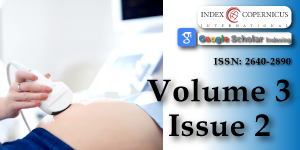Establishment of a new reference line for 2D transperineal ultrasound in urogynecology
Main Article Content
Abstract
Background: The purpose of this study was to establish a new, reliable and reproducible reference line for assessing bladder neck descent using 2-dimensional transperineal ultrasound. Therefore, we created a novel line, named Symphysis-Levator Line (SLL) and defined it as the connecting line between the hyperechogenic, dorsocaudal edge of the symphysis pubis and the hyperechogenic anterior margin of the puborectalis muscle, posterior to the anorectal junction.
Methods: A retrospective study was performed including 111 patients, who underwent a transperineal ultrasound as part of an urogynecological examination in the department of Urogynecology at the University Medical Center of the Johannes Gutenberg University Mainz. We calculated the bladder neck decent using the SLL and compared our results with the measurements assessed using a horizontal line through the infero-posterior margin of the symphysis pubis, as previously described by Dietz (Horizontal Symphysis Line, HSL). In addition, we calculated the intra- and interobserver reliability of the two methods and examined the influence of various patient characteristics on the obtained values.
Results: Both methods demonstrated a high intra- and interobserver reliability. Even though the HSL produced slightly higher numerical values for the bladder neck descent, the novel SLL was more precise. Our data support that the 2-point fixation of the SLL on two anatomical structures ensures the stability of the reference plane during the functional changes of the pelvic floor.
Conclusion: The Symphysis-Levator Line could be a useful tool for urogynecologists in the future.
Article Details
Copyright (c) 2020 Dionysopoulou A, et al.

This work is licensed under a Creative Commons Attribution 4.0 International License.
Jamard E, Blouet M, Thubert T, Rejano-Campo M, Fauvet R, et al. Utility of 2D-ultrasound in pelvic floor muscle contraction and bladder neck mobility assessment in women with urinary incontinence. J Gynecol Obstet Hum Reprod. 2020; 49: 101629. PubMed: https://pubmed.ncbi.nlm.nih.gov/31499282/
Dietz HP. Why pelvic floor surgeons should utilize ultrasound imaging. Ultrasound Obstet Gynecol: 2006; 28: 629-634. PubMed: https://pubmed.ncbi.nlm.nih.gov/17001745/
Dietz HP, Wilson PD. Anatomical assessment of the bladder outlet and proximal urethra using ultrasound and videocystourethrography. Int Urogynecol J Pelvic Floor Dysfunction. 1998; 9: 365-369.
Schaer GN, Koechli OR, Schuessler B, Haller U. Perineal ultrasound for evaluating the bladder neck in urinary stress incontinence. Obstet Gynecol. 1995; 85: 220-224. PubMed: https://pubmed.ncbi.nlm.nih.gov/7824234/
Dietz HP, Bernardo MJ, Kirby A, Shek KL. Minimal criteria for the diagnosis of avulsion of the puborectalis muscle by tomographic ultrasound. Int Urogynecol J. 2011; 22: 699-704. PubMed: https://pubmed.ncbi.nlm.nih.gov/21107811/
Dietz HP, Shek KL. Tomographic ultrasound imaging of the pelvic floor: which levels matter most? Ultrasound Obstet Gynecol : the official journal of the International Society of Ultrasound in Obstet Gynecol. 2009; 33: 698-703. PubMed: https://pubmed.ncbi.nlm.nih.gov/19434620/
Orno AK, Dietz HP. Levator co-activation is a significant confounder of pelvic organ descent on Valsalva maneuver. Ultrasound Obstet Gynecol : the official journal of the International Society of Ultrasound in Obstet Gynecol. 2007; 30: 346-350. PubMed: https://pubmed.ncbi.nlm.nih.gov/17702054/
Dietz HP, Clarke B. The influence of posture on perineal ultrasound imaging parameters. Int Urogynecol J and pelvic floor dysfunction. 2001; 12: 104-106. PubMed: https://pubmed.ncbi.nlm.nih.gov/11374506/
Mouritsen L, Bach P. Ultrasonic evaluation of bladder neck position and mobility: the influence of urethral catheter, bladder volume, and body position. Neurourol Urodyn. 1994;13: 637-646.
Wen L, Zhao B, Chen W, Qing Z, Liu M. Real-time assessment of the behaviour of the bladder neck and proximal urethra during urine leaking in the cough stress test (CST) in supine and standing positions using transperineal ultrasound. Int Urogynecol J. 2020. PubMed: https://pubmed.ncbi.nlm.nih.gov/32291473/
Dietz HP. Pelvic floor ultrasound: a review. American journal of Obstet Gynecol. 2010; 202: 321-334. PubMed: https://pubmed.ncbi.nlm.nih.gov/20350640/
Tunn R, Petri E. Introital and transvaginal ultrasound as the main tool in the assessment of urogenital and pelvic floor dysfunction: an imaging panel and practical approach. Ultrasound Obstet Gynecol : the official journal of the International Society of Ultrasound in Obstet Gynecol. 2003; 22: 205-213.
Interdisciplinary S2k Guideline: Sonography in Urogynecology: Short Version AWMF Registry Number: 015/055. (Gebfra 2014).
Albrich SB. Urogenitalsonographie des weiblichen Beckenbodens Ultraschalldiagnostik bei urogynäkologischen Fragestellungen. Gynäkologe. 2018; 51: 208-216.
Herschorn S. Female pelvic floor anatomy: the pelvic floor, supporting structures, and pelvic organs. Reviews in urology. 2004;6 Suppl 5: S2-s10. PubMed: https://www.ncbi.nlm.nih.gov/pmc/articles/PMC1472875/
Dietz HP, Shek C, De Leon J, Steensma AB. Ballooning of the levator hiatus. Ultrasound Obstet Gynecol : the official journal of the International Society of Ultrasound in Obstet Gynecol. 2008; 31: 676-680. PubMed: https://pubmed.ncbi.nlm.nih.gov/18470963/
Dietz HP, Simpson JM. Levator trauma is associated with pelvic organ prolapse. BJOG 008; 115: 979-984. PubMed: https://pubmed.ncbi.nlm.nih.gov/18503571/
Shek KL, Pirpiris A, Dietz HP. Does levator avulsion increase urethral mobility? European journal of obstetrics, gynecology, and reproductive biology. 2010; 153: 215-219.
Dietz HP, Kirby A, Shek KL, Bedwell PJ. Does avulsion of the puborectalis muscle affect bladder function? Int Urogynecol J Pelvic Floor Dysfunction. 2009; 20: 967-972.
Dietz HP, Lanzarone V. Levator trauma after vaginal delivery. Obstet Gynecol. 2005; 106: 707-712. PubMed: https://pubmed.ncbi.nlm.nih.gov/16199625/
Viereck V, Pauer HU, Hesse O, Bader W, Tunn R, et al. Urethral hypermobility after anti-incontinence surgery - a prognostic indicator? Int Urogynecol J and pelvic floor dysfunction. 2006; 17: 586-592.
Naranjo-Ortiz C, Shek KL, Martin AJ, Dietz HP. What is normal bladder neck anatomy? Int Urogynecol J. 2016; 27: 945-950. PubMed: https://pubmed.ncbi.nlm.nih.gov/26700104/
Dietz HP, Eldridge A, Grace M, Clarke B. Pelvic organ descent in young nulligravid women. American journal of Obstet Gynecol. 2004; 191: 95-99. PubMed: https://pubmed.ncbi.nlm.nih.gov/15295348/
Peschers UM, Fanger G, Schaer GN, Vodusek DB, DeLancey JO, et al. Bladder neck mobility in continent nulliparous women. BJOG. 2001; 108: 320-324. PubMed: https://pubmed.ncbi.nlm.nih.gov/11281475/V
Reed H, Freeman RM, Waterfield A, Adekanmi O. Prevalence of bladder neck mobility in asymptomatic non-pregnant nulliparous volunteers. BJOG. 2004; 111: 172-175.

